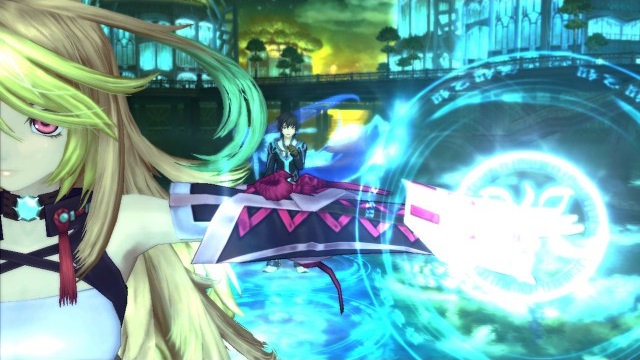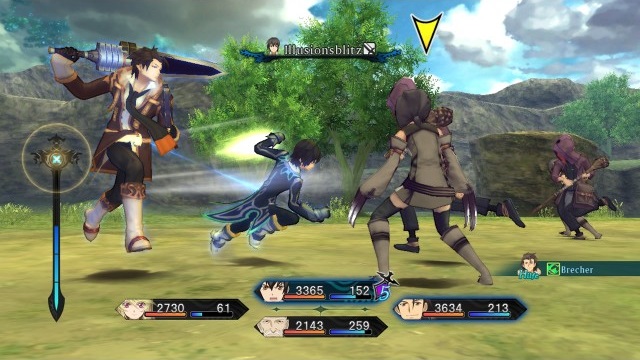A Tale for the Ages.
There's just something about the Tales franchise that tickles this old man's nostalgia bone. Though the series is by no means stuck in the past, it bears the unmistakable stamp of the JRPG of yesteryear. You have high drama giving way to playfully light-hearted banter, elaborate combat, and progression systems, and characters who somehow manage to remain relatable no matter how outrageously they react to the events unfolding around them. It's the kind of tonal loopiness that would make the adult in me feel silly for playing, if only the kid in me could stop gleefully bouncing of the walls. Tales of Xillia appeals directly to that inner RPG child with a quest that's as memorable for its quirky characters as it is for its frenetically paced combat.
Xillia wastes no time getting the narrative train out of the station, and it mostly keeps the brisk pace it establishes early. There's a pleasing inertia to the way plotlines form, unfold, and reach a conclusion that propels our heroes ever-forward, never stopping long enough to feel meandering but never feeling rushed or forced either. Its efficiency at telling its tale is one of its most impressive qualities, hooking you into new characters at regular intervals and developing them meaningfully without keeping you out of the action for too long.
And that's a very good thing, as the real-time combat is undoubtedly the beating heart of Tales of Xillia. I don't know what kind of dark magic Namco used to make the fighting feel so breezy and immediate while retaining all the RPG depth, but if other devs have to worship some sort of dark lord to learn it and duplicate it, I wouldn't judge. Characters snap out every well-animated punch, kick, and slash as if they were made of water, making Xillia fun even when you're just mashing out basic combos. But once you learn the many nuances of its combat system, it's doubtful that you'll lean on such simplistic tactics, not only because they stop being effective at a certain point, but because there's so much other cool stuff to do that mercilessly assaulting the X button will seem pedestrian by comparison.
This is in large part thanks to the new “link” system which allows you to choose a partner to work in tandem with you in battle. Linked partners will follow you about, attacking your targets from the rear to land critical hits, and using their special support ability when the appropriate situation arises. It also makes it possible to combine special attacks (called artes in Tales speak) into flashy-looking super moves, which themselves can be chained with good timing under the right circumstances. Each party member gets a huge number of artes over the course of the 40-hour quest, so you'll be swimming in possibilities. And since you can switch who you control, and who they're linked to mid-combo, fights turn into swirling melees of swords and sorcery, leaving you feeling both accomplished and ready for the next scrap.

Underpinning it all is an intricate suite of RPG systems that successfully lend weight to the urgency and fluidity of combat. Every element of your party's behavior and capabilities can be tweaked, allowing you to tailor an approach that fits your style. The Lillium Orb system is a particular standout, riffing on the now standard orb sphere/license board concept popularized by Final Fantasy X. Planning how you'll zig and zag through this web-like maze of abilities and attributes is an enormously good time, as it challenges you to make meaningful progression decisions without hopelessly borking your character should you make a few less-than-optimal choices. Much like the combat, there's tremendous depth here, but just as much flexibility.
Of course, it isn't all roses for the thirteenth main Tales game. In terms of overall presentation, there's a blemish or two worth noting. The series has never been one to be on the bleeding edge of graphical technology in the first place, but Tales of Xillia comes to us North Americans pre-aged, having been out in parts East for two years now. The beautiful artwork does much to acquit it, but it's pretty tough to ignore how basic and sheenless some of the environments and character models look. Tougher to ignore is the way people and objects just sort of pop in as you walk about, harkening back to the “good ole days” when 3D environments were new, system-straining affairs. In combat, where it counts, Xillia's speed and style keep it looking fresh, but it's visually stale otherwise, excepting the incredible, but disappointingly rare animated cutscenes.

The sound department is in better shape, but it's far from perfect either. The orchestral soundtrack exudes constant excellence from beginning to end, but the same cannot be said for the voice work. Some characters sound fine, even terrific, but others had me sighing up a storm. Regrettably, the worst offender happens to be one of the two main characters, Milla, whose attempts at sounding reserved and emotionally distant come off instead as robotic and forced. It was bad enough that I scrambled to the options in hopes of finding a Japanese language option to see if it would be an improvement, but alas, there was none to be found. After Namco Bandai included dual audio for Ni No Kuni, I had hoped it would become their standard going forward. Now I know that hope is a foolish thing to have. Always. Thanks, Namco Bandai.
At the end of the day these are mostly minor quibbles that do nothing to stop the action from being addictive or the story from being absorbing. It takes much bigger bumps in the road to keep Xillia's journey from being enjoyable, especially if you have a long-standing love of the genre. In a world where RPGs seem to fly spastically to either extreme of the Eastern/Western spectrum, Tales is that rare, moderate candidate that sensibly takes the best of both worlds and makes it into something any fan of the genre can enjoy, without betraying what the purists love. There's no reason for any RPG fan to miss this one.
-
Perfectly paced plot
-
Deep, addictive, fast-paced combat
-
Gorgeous artwork, gorgeously animated
-
Show its age technically
-
Engaging character progression system
-
Beautiful orchestral soundtrack
-
Wildly inconsistent voice acting
-
No dual audio. 🙁







